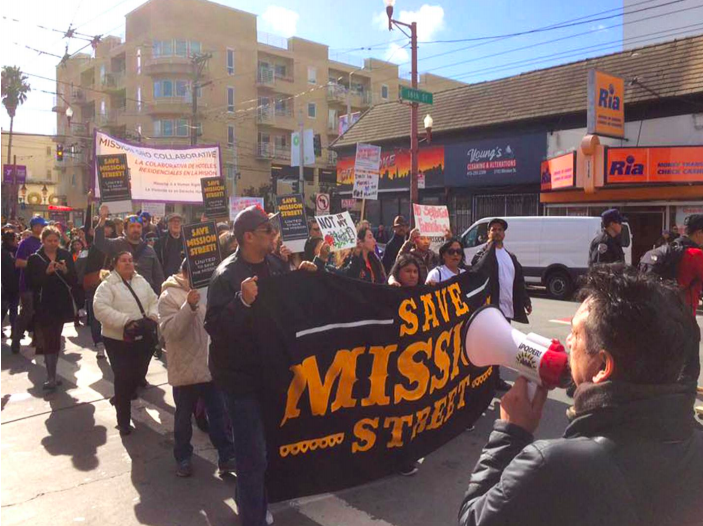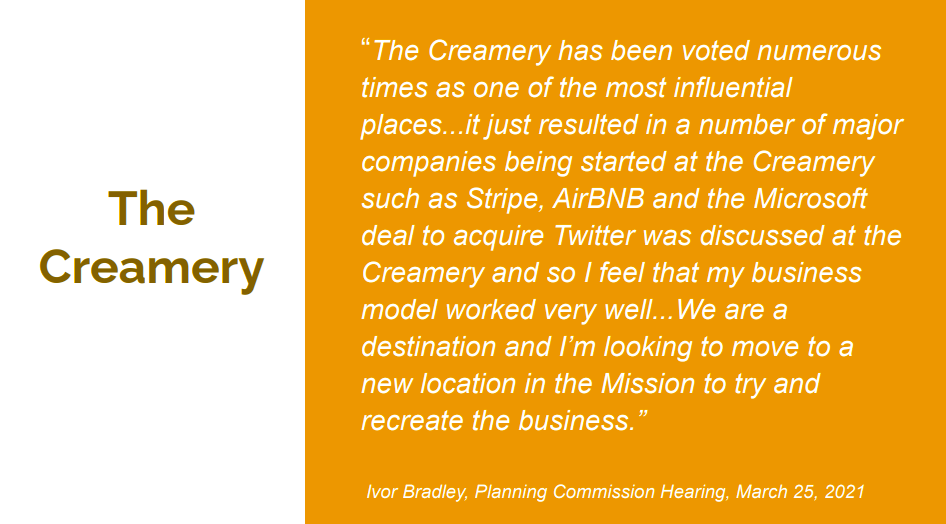To read Heather Knight in the Chronicle, there’s a horrible waste of time and an abuse of process going on in the Mission.
The headline:
S.F. cafe owner battles red tape and ‘folks who just hate everything’ in fight to open in the Mission
The story:
When Ivor Bradley goes before San Francisco’s most powerful legislative body Tuesday, he won’t be arguing for anything extraordinary. Instead, the Board of Supervisors will spend precious time debating a controversy that could only happen in San Francisco: whether to let Bradley open a coffee shop.
The fight over croissants and cappuccinos promises to be the most San Francisco story of them all — one that covers the city’s tech industry, its small business crisis, its intense NIMBY-ism and its famously dramatic fights over every little change proposed to the city’s landscape.
Oh, the horror.

But there’s a lot more to this story.
Ivor Bradley isn’t just trying to open a coffee shop. He’s proposing to relocate The Creamery – a place where techies and venture capitalists met to close deals, where Stripe and Airbnb were started – from Soma to 14th and Mission.

It’s been described as “one of the tech world’s favorite gathering places – and now, Bradley has said he wants to make it a “destination.”
At 14th and Mission.
As Larisa Pedroncelli, a small business owner and member of United to Save the Mission, told me, “we know what the impacts of this tech-centered café will be.”
When The Slanted Door restaurant opened on Valencia Street in 1995, that was still a place where small local businesses owned by immigrants and people of color thrived. But that “destination” restaurant soon brought other “destination” establishments. Rents went up, way up. Now, much of Valencia is fully gentrified.
“I don’t think that’s what [founder] Charles Phan intended, but it was the result,” she said.
Oh, and the café would be situated right in the middle of the American Indian Cultural District.
So Mission community activists have appealed the project’s environmental review. It came before the Board of Supes today.
Ben Terrell, a freelance writer arguing for the Cultural Action Network, asked the supes to “wipe your mind of the SF Chronicle piece that ignored the racial equity issues.”
This case, he said, “is all about displacement.”
The owners of several small cafes in the area (there are six within 700 feet) testified that they won’t survive if the Creamery comes in. Others said that they feared that the north end of Mission St. would become like Valencia.
A lawyer for Bradley argued that there’s no specific environmental impact here, that the gentrification of a long-time immigrant neighborhood doesn’t count under CEQA.
The supes agreed. “I understand the anxiety and frustration, but I believe CEQA is not a tool fit for this purpose,” Sup. Hillary Ronen, who represents the district, said.
Terrell put forth a different argument: He said that under CEQA, the city needs to consider socio-economic impacts that lead to environmental impacts. The Planning Department never really responded to that — as is common.
But let’s be real here. This was not a “NIMBY” appeal. These are not people “who hate everything.”
The people who opposed the Monster in the Mission weren’t “NIMBYs” either – they were longtime community activists who realized that some types of new housing and some types of businesses are going to drive up property values, bring in speculators, and displace long-term residents and businesses.
Maybe that’s not an issue under CEQA. “CEQA doesn’t cover gentrification,” Ronen said.
Maybe the city – which, as affordable housing activist John Elberling likes to point out, has no “anti-gentrification” plan – needs to find another sort of analysis.
Maybe there should be an economic impact analysis that looks at how a project will affect existing vulnerable communities.
These are legitimate issues. Bradley has plenty of money and resources, and can take his Creamery anywhere in the city; he doesn’t need to be at 14th and Mission, where the existing small business community is very, very fragile.
There’s no process for that sort of appeal right now. But until we have commercial rent control and real residential rent control and eviction protections for residential tenants, there ought to be.
That’s the story Heather Knight missed.



